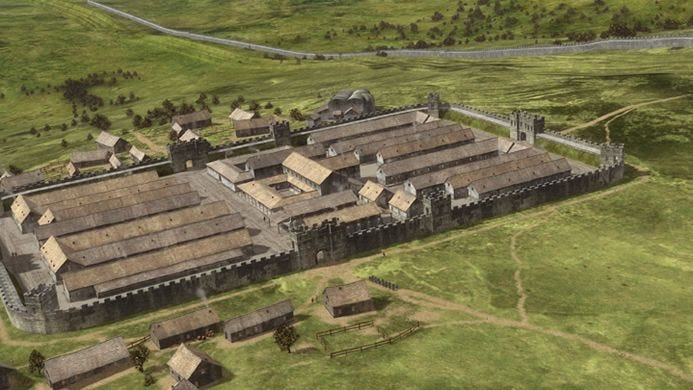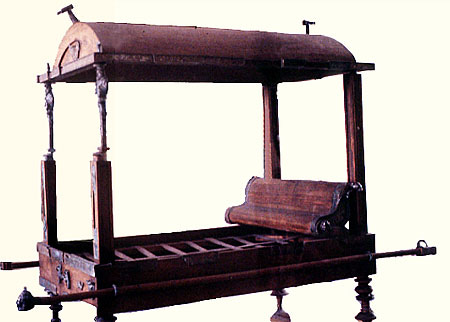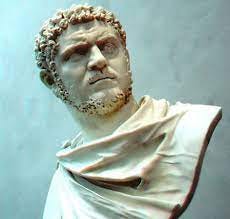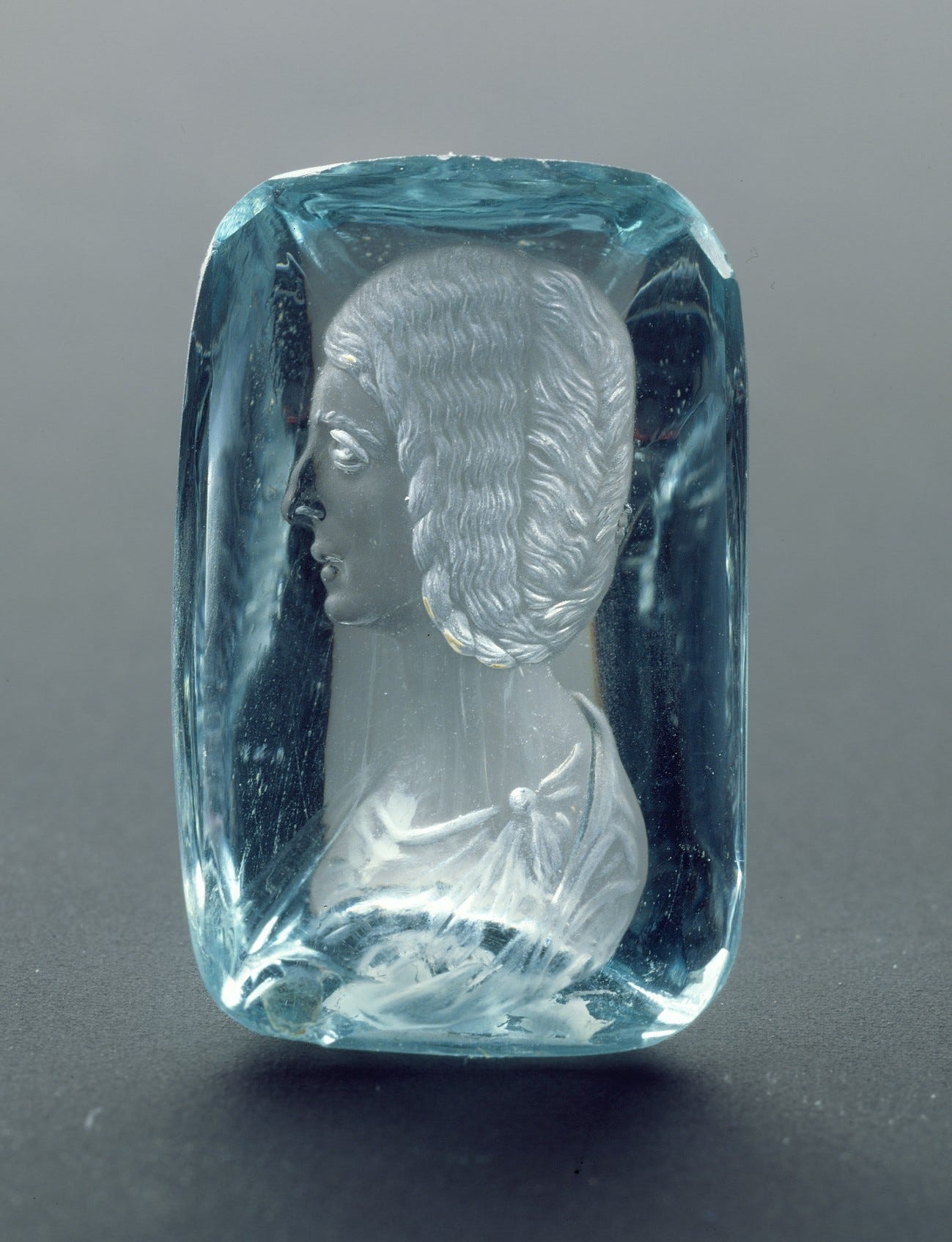How Rome’s first black Emperor and his wife ruled the world from Carlisle
In 208 AD, Septimius Severus launched a four-year war against Caledonians from the Cumbrian capital. He built a lavish baths complex there to cosset Julia Domna while he was fighting
New book! Free extract!
By the time Emperor Septimius Severus and his enormous entourage reached Luguvalium (Carlisle), the pains in his legs and feet were excruciating. The agony was far worse than when he broke his nose as a young man and passed out, we are told. He was in such discomfort that he was being carried through the gate of the main fort on Hadrian’s Wall in a curtained, elaborately decorated, litter.
Severus was sitting up in a kind of portable bed and bracing himself against a cushioned seat. Thanks to the nimbleness of his anxious slaves Severus had been protected from the discomforts of the uneven roads on the journey up from York. That was fortunate because even the lightest touch of a blanket on his toes was torment.
But he resented being forced to adopt this undignified means of travel. All his life, Emperor Septimius Severus had been a physically strong, powerful, and energetic man. He had commanded armies, usually from the back of a tall, 70 stone Arab horse. He was small but contemporary portraits convey his extraordinary dynamism. He had the keen, searching and slightly suspicious look of a man who wished his education had been better and who was determined never to be outwitted.
But now Severus was half-crippled with the worst pain he had ever experienced. He was suffering from what the Greek physician Hippocrates had identified as podagra or the “unwalkable disease.” Today, we call it gout. Severus’s hearty devotion to red meat and shellfish played a part in this flare-up. The Emperor was a hot-tempered and impatient man at the best of times. But to be disabled in the late spring of 208 AD, just as he arrived at Carlisle prior to a huge military operation, was an almost unendurable joke by the gods.
Fortunately, he had his aggressive son Antoninus at his side ready to act as joint commander. This rather frightening 20-year-old is better known to history by the name the plebs gave him, “Caracalla.” They called him that after the Celtic hooded cloak he started wearing when he arrived in the place we now call Cumbria. He donned the long, heavy woollen garment beloved of the locals when he discovered it was impregnated with lanolin. The smelly oil made it waterproof. He decided that would be very useful on campaign.
From Carlisle, Severus planned to lead the vast army of 57,000 men that he had assembled in Britain north into extremely hostile territory. That is a lot of men. By comparison, the US contingent that took part in the D-Day landings of the Second World War was 73,000 strong. Luguvalium was a logical place to choose as his summer headquarters.
This is because, if the enemy attacked, they would most likely come down the west coast. After all, it was the route the rebel rising of 117 AD had taken. Carlisle was also where the most powerful single Roman regiment in Britannia, the Ala Petriana, was stationed. This was the largest imperial unit of auxiliary soldiers on the island. It was the only Ala Milliaria – a phrase that denotes an elite cavalry formation composed of conscripts from Rome’s Italian allies - on Hadrian’s Wall. It was also the only double strength cavalry regiment in the country.
It comprised 1,000 horsemen plus many support personnel. Today, the site of the Petriana base is buried under the Carlisle suburb of Stanwix, which the Romans called Uxelodunum, just across the River Eden. In Severus’ day, there was a bridge built by Hadrian linking the fort to the cavalry base. In 1951, nearly 100 stones from the structure were dredged from the river and they can be seen today in Bitts Park. If it hadn’t been for the memory of the Boudiccan uprising and various other rebellions, Severus might have stayed in warmer climes.
Septimius Severus led an enormous army from Carlisle aiming to put right the biggest mistake made when the Romans first conquered Britain - failing to defeat the Caledonians in the North
But a couple of things drove him on. He had won the throne in a coup d’etat and one of the opponents he defeated was the Governor of Britain. The local troops had backed their man and Severus wanted to ensure their loyalty. Secondly, Hadrian’s Wall was in a bad way by this time and the Scottish tribes kept crossing the border. It was time for a major rebuild.
Another daunting objective Severus had set himself was to put right the mistake made by the Roman Emperor Domitian in withdrawing his general Julius Agricola from Britain in 85 AD before the whole island had been conquered. Ever since, the rebellious Caledonians had proved murderously troublesome. A major war between the Romans and the northern tribes had broken out in 180 AD. As the Roman historian Cassio Dio put it “the tribes crossed the Wall which divided them from the Roman forts and killed a general and the troops he had with him.”
Now the problem had worsened so that it had become a threat to the entire Roman occupation. Septimius had quite possibly read Tacitus’ Life of Agricola and his Histories, in which the “complete conquest of Britain” by the historian’s father-in-law was immortalised—and its abandonment denounced. In response to the latest crisis, Severus had ordered a major operation. He imported into Britain the core of his imperial court and retinue. The party included the praetorian prefect Papinian, essentially the Emperor’s top official and the fleet commander whose 7,000 sailors and marines were crucial to the mission.
The Rhine and Danube armies contributed and a new legion, II Parthia, part of Rome’s garrison, accompanied strong elements of the Praetorian Guard – an elite force who were the emperor's bodyguards that Severus had doubled in size when he became emperor. It included the imperial guard cavalry which the emperor had also multiplied by two. His personal army, the Legio II Parthica came along. He also had the three legions based in Britain, 15,000 British Auxiliaries, troops from the Rhine and Danube, transport soldiers and the navy.
A large number of imperial slaves and freedmen from the Familia Caesaris or household also came along. They were there to run every detail of the Emperor’s day-to-day life right down to the single slave employed solely in setting Julia’s jewellery.
The sources name two others, Castor the Chamberlain and Euodus, Antoninus’ tutor, as being in the party. Bringing his government with him meant Severus could run the Empire from Carlisle and York while fighting what he calculated would be a four-year war.
Severus was accompanied by his beautiful, highly intelligent, witty, and independently wealthy wife, Julia Domna, fifteen years his junior. She was a significant political player in her own right. Julia was a Syrian Arab descended from a dynasty of priest-kings. Her family’s influence across the east was vital in keeping Severus, and later her son, in power.
Julia’s portrait was widely distributed across the Empire as part of the propaganda campaign by her ambitious family. One example, dating to precisely this time, is an exquisite engraving of her attractive profile carved into a pale green transparent jewel made of beryl. She is wearing her hair elaborately pinned up Roman-style and the lightest patterned silk gown.
For the comfort of this stunning woman, as we shall see, the Emperor spared no expense. The imperial pair were style icons who influenced fashion and culture in Luguvalium and Severus’s winter headquarters, Eboracum , the place we know as York. Severus was an arrogant man. He came from a wealthy and distinguished family of equestrian status, the level just below the top senatorial rank. His sense of superiority was bolstered by his achievements.
He had become the greatest expander of the Empire since Emperor Trajan a century before. Severus had already lived ten years longer than most other Emperors. He had celebrated his sixty-third birthday that April, a landmark the Greeks called the “Grand Climacteric.” Astrologers (who Severus took seriously) had warned him with their usual talent for stating the obvious that a person that age was at great risk of death. But Severus set out for Britain anyway, as the historian Cassius Dio wrote, “in his heart more enthusiastic than any youth,” knowing from omens that he would not return and would die in his third year in the island.
The Emperor had an insatiable lust for glory. He was damned if he would waste his final years in the toils of Roman politics or chasing petty brigands around Italy. He was also irritated and alarmed by the mutual hatred between his two inadequate sons, Antoninus and his elder brother Geta. After Severus’ death in 221, Antoninus would kill Geta in order to gain full command of the Roman Empire.
But he reigned as Emperor for only five years before being assassinated by a soldier he had humiliated. Severus disliked the boys’ dissolute habits and their taste for vulgar shows in the Roman Forum: a rhinoceros confronting a bull, a woman slaying a lion. He thought it would be healthy to remove his squabbling heirs from the fleshpots of Rome - and he was eager to score a triumph against the Britons, another trophy to add to the victories and titles he had won in the east and the north. Severus was renowned for his ruthlessness and he was widely unpopular for having taken power in a military coup, though it was relatively bloodless.
He was not articulate and rarely spoke in public. Cassius Dio said, “Severus was careful of everything that he desired to accomplish, but careless of what was said about him.” He could afford to ignore the critics because he had reigned longer than most emperors and, unlike many of them, his rule had brought glory and peace. Severus was also the first African Emperor, born in Leptis Magna, the present-day Libyan town of Khoms. His black skin was not an issue in the cosmopolitan Empire. The Romans did practice discrimination, but not on the basis of race.
Before the British adventure, Severus’s boredom had reached unbearable levels. With suspiciously convenient timing, he received a letter from the Governor of Britain, Alfenus Senecio, one of the Emperor’s most trusted aides. It is quite possible Severus concocted this letter himself so that he had an excuse to escape Rome.
Alfenus was another brown-skinned North African, born in Numidia, present day Algeria. He was probably descended from Berber merchants and nomads of the Sahara. His name is recorded in no fewer than nine inscriptions across the north of England. He was responsible for major works there such as building granaries at Birdoswald fort in Cumbria.
His letter to Severus said the barbarians were in revolt and laying waste to the countryside, carrying off plunder and destroying almost everything. The unstated subtext was that this was Severus’s own fault. He had left Hadrian’s Wall undermanned because he feared a too big a force would rebel and try to topple him as emperor. Senecio warned the situation was so bad that the whole island of Britannia could be overrun. Hence there was a need for more troops to reinforce the British garrison or the imperial presence. Senecio got both.
Senecio had done some fighting as well as building in northern Britannia, and that made the Emperor envious. Another historian, Boris Rankov, argues the trip was more about reinforcing the loyalty of the army in a province that Severus was concerned could be a centre of rebellion against his rule. But the majority of observers agree with Dio, that Severus “was becoming angry that in Britain he was winning wars through others while being worsted by a brigand in Italy.” It would be wrong to minimise the seriousness of the Caledonian rebel attacks and their effect in undermining Rome’s authority in Britain. Severus may well have felt the Empire was in retreat there.
When Severus was a boy, the northern limit of the Roman Empire had been the Antonine Wall. It extended about 36.5 miles across Scotland between the River Clyde and the Firth of Forth. It was about 100 miles north of Hadrian’s Wall. Above the Antonine lived two hostile confederations of tribes, some Celts called Caledonii in the far north and the Maetae to the south and east. But by the 160’s, barely 20 years after the Antonine was constructed, the Romans had, under ferocious attack from the inhabitants, abandoned the more northerly barrier.
The sources are unclear, but it seems Severus may have ordered Senecio’s predecessors to try reinstating it, with little success. Beginning in 205, the Emperor had ordered Senecio to launch a programme of fort-refurbishment across Hadrian’s Wall. This included rebuilding wood and turf sections in stone. As the work of placing the province on a more secure military footing came to completion Severus decided it was the right time for a personal intervention. As historian Godfrey Hodgson put it, Severus saw himself as “an energetic and belligerent emperor taking the field to bring final resolution to the problem and unite his sons, now grown into mutually antagonistic young men, in an urgent and worthwhile task.”
But what was Severus’s real objective? Cassius Dio wrote that the emperor was: “wishing to subjugate the whole of [the island].” But Francis Haverfield argues Severus’s expensive upgrading of Hadrian’s Wall suggests he did not march to annexe, occupy, and directly govern Caledonia, more to launch the mother of all punishment raids. Refurbishing Hadrian’s great barrier was not the only building project the emperor had commissioned in advance of his arrival.
One major scheme was carried out with the happiness and comfort of his wife Julia in mind. In 2017, archaeologists discovered an elaborate Roman bathhouse on a site within the grounds of the present-day Carlisle Cricket Club. Archaeologists called the revelation “simply stunning.” They found original floors, walls, painted plasterwork, immaculately preserved coins and cooking vessels, hairpins, and arrowheads.
The bathhouse, could be dated to the early 3rd Century, in other words, the time of Severus’ military campaign. Archaeologists uncovered a “uniquely large” number of tiles on the site. Many were embossed with the official Roman Imperial stamp “IMP.” This is an extremely rare item to turn up in any archaeological dig. The initials stand for Imperator, Latin for emperor. Dr Dot Boughton from Carlisle’s Tullie House Museum said that by applying this rare and exclusive stamp, the tilery was effectively saying they are “supplying tiles fit for the emperor” or “on the emperor’s demands.”
If any further evidence were needed that the imperial couple were in Carlisle in the early years of the third century, the archaeologists found a carved sandstone slab with a tribute to the Empress Julia Domna in exceptional condition.
Frank Giecco, lead archaeologist of Uncovering Roman Carlisle which excavated the baths, said of the inscriptions: “this is the signature of the Emperor. It’s been built by the imperial machine and it’s a connection.” If any further evidence were needed that the imperial couple were in Carlisle in the early years of the third century, the archaeologists found a carved sandstone slab with a tribute to the Empress Julia Domna in exceptional condition.
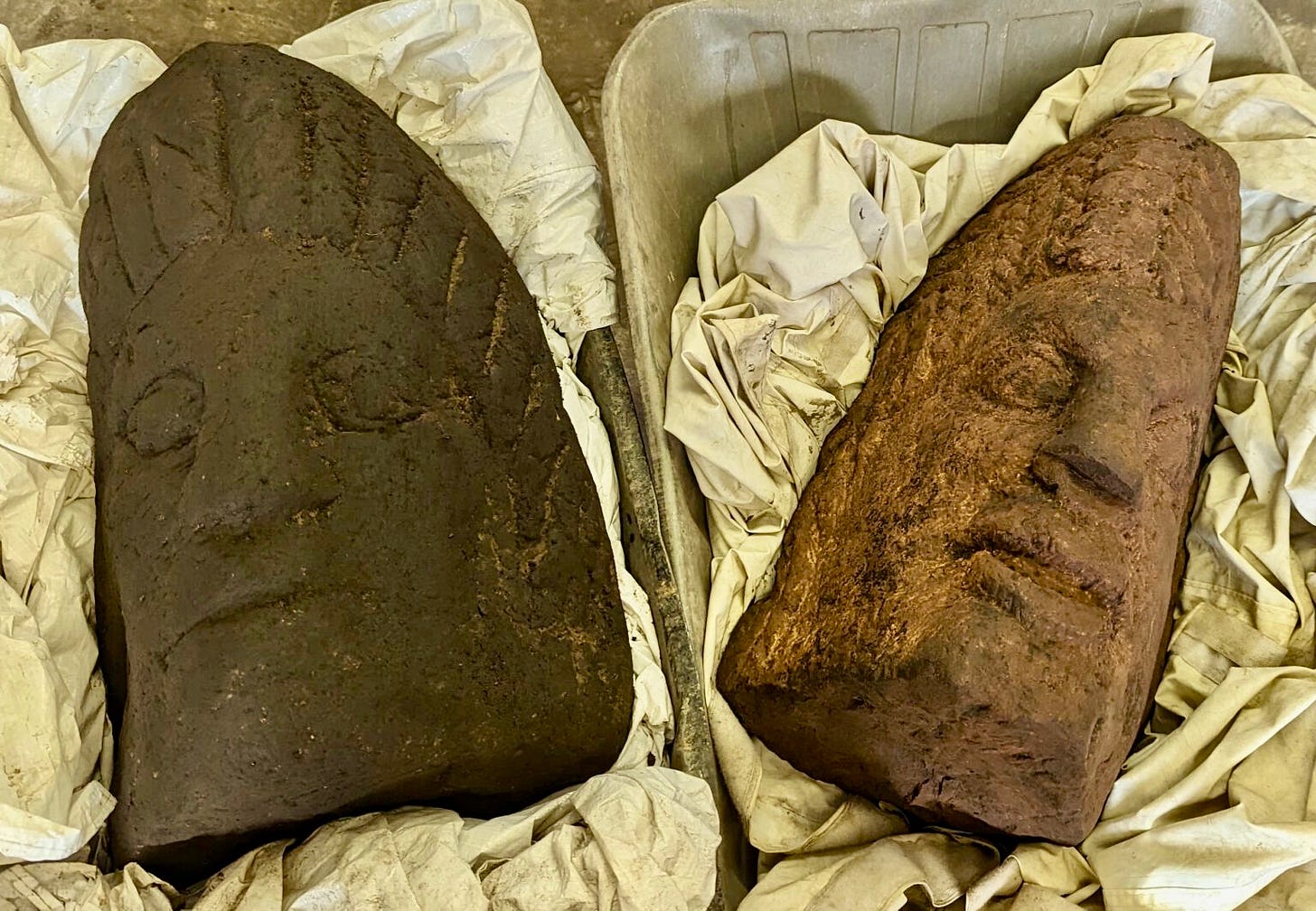
The position of the baths beside the River Eden is also highly significant: it forms a tight unit with the fort and the cavalry base. This would have made it highly convenient for the empress and her women to walk safely from their apartments in the fort to the state-of the art bathing facility.
“This entire complex was a place built by a Roman emperor for his wife because he was going on campaign for four years and wanted to keep her sweet.”
Mr Giecco added: “The emperor was in Britain at that time, we’ve got an inscription from his wife in the building and we have got his personal workshop-stamped tiles coming from the building. The evidence is building up that there is something really special going on here.”
He added: “This entire complex was a place built by a Roman emperor for his wife because he was going on campaign for four years and wanted to keep her sweet.” Another sign of the building’s very special status is that it had soaring arched ceilings inside, constructed using hollow terracotta tubes that locked together end-to-end. This allowed the architect to achieve an elegant, vaulted interior without having to employ heavy, solid stone. The tubes could be made rapidly by potters on site and because they held themselves up there was no need for large amounts of timber scaffolding during construction.
These hollow tubes were a new technology in the third century. They were first developed in Severus’s home territory of North Africa. It seems significant that an advanced piece of technology so closely associated with Severus should have appeared in Cumbria at this date. The Carlisle baths are built around five main rooms all with hypocaust underfloor heating. The three principal rooms in the bath included a warm space called the tepidarium, a hot one called the caldarium, where slaves would rub their masters all over with perfumed oil and then scrape it off with a knife called a strigil. There was a big cold bath called the frigidarium to swim in afterwards.
Archaeologists found copious amounts of Roman tile used in creating heating conduits and forming floor supporting columns. The high quality and large extent of the baths made it a site of “great significance,” Mr Giecco wrote in his report for Wardell Archaeology. “This building was constructed on a truly monumental scale,” stretching 132 feet by 114 feet. It “would have been one of the largest buildings in Roman Carlisle” but it was also set inside a much larger complex only 20 per cent of which has been excavated so far.
This is an extract from a chapter in a new book called The Trophy at the End of the World. You can buy it instantly here:
: https://www.fletcherchristianbooks.com/product/the-trophy-at-the-end-of-the-world
Or you can pick up a copy from the New Bookshop, Main Street, Cockermouth, Bookends in Keswick or Carlisle and Sam Read in Grasmere.





